Enantioselective Multidimensional Gas Chromatography for the Analysis of Selected Monoterpenic Compounds in Melaleuca alternifolia (Tea Tree) oil
Rachel West[1], Yong Foo Wong[2] and Philip J. Marriott[3], Department of Chemistry, University of Warwick, and Australian Centre for Research on Separation Science (ACROSS), School of Chemistry, Monash University
Abstract
The present work is focused on developing an approach to the determination of enantiomeric fractions of limonene, terpinen-4-ol and α-terpineol in tea tree oils (TTOs), by means of heart-cutting multidimensional gas chromatography with mass spectrometry (MDGC; GC–eGC-QMS) detection, and conventional enantioselective-GC with flame ionisation detection (eGC-FID). eGC corresponds to an enantioselective-phase column, and is selected here to provide acceptable resolution of the enantiomers of the target compounds. However, eGC-FID is found to suffer chemical overlap with another compound, and so prevents quantitative analysis. In MDGC analysis, the eGC column is located as the second column. By contrast, using the GC–eGC-QMS approach allows the individual optically active compound to be separated from the interfering matrix components, prior to chiral separation in the second dimension column. The results obtained by using both methods were compared and discussed. This developed method can serve as an effective approach to determining the authenticity of TTO in view of the current growing trend towards adulteration of natural oils and products.
Keywords: Gas chromatography, limonene, terpinen-4-ol, α-terpineol, enantiomeric analysis, GC–eGC-QMS, tea tree oil.
Introduction
In recent years, the global market of essential oils has shown a remarkable growth correlating to an increase in demand. According to the United Nations Comtrade, the estimated global market for the essential oil trade was around US$24 billion for the year 2011, with an annual growth rate of 10% (Ramu Govindasamy, 2013: 289–321). Chemically, essential oils are complex mixtures composed of natural, volatile and semi-volatile organic compounds characterised primarily by a strong and distinctive odour usually related to the source plant. The Australian native plant, Melaleuca alternifolia, is a genus of tall shrub cultivated mainly for its volatile oil, commonly known as tea tree oil (TTO) (Brophy et al., 2013: 40–45; 50–51). The annual value of TTO was reported to be in excess of A$15–20 million at the farm gate (Brophy et al., 2013: 41). TTO is composed mainly of terpene hydrocarbons, principally monoterpenes, sesquiterpenes and their associated oxygenated species. The natural content of each compound in the oil varies considerably depending on the duration of distillation, the temperature at which the oil is stored, the age of the leaves, and also the environment in which the plant grows (Sciarrone et al., 2010: 6422–27).
Adulteration of essential oils is not uncommon along the supply chain from manufacturer to customer, which is of concern to the essential oil and aromatherapy industry. When adulteration occurs, the composition will no longer represent the product quality that the purchaser expects; the adulterant will rarely be subject to quality control standards. Adulteration may be based on the relative market prices of the oil and the proposed adulterant (Tisserand and Young, 2014: 9–10), and the ease with which the product may be adulterated. The analytical technique of gas chromatography (GC) can be extremely useful in detecting adulteration; it is a highly efficient volatile organic compound separation technique, where vaporised compounds are distributed between two phases (mobile gaseous phase and stationary phase). The chemically inert mobile phase carries vaporised analytes through the column to a suitable detector. Chemical separation within the column is based on relative vapour pressures and affinities of analytes to the stationary bed. Ideally, the goal of a GC analysis is to resolve and identify all compounds, but often components cannot be fully resolved, nor adequately identified.
Enantioselective-GC (eGC) extends conventional GC to the enantioselective separation of enantiomeric pairs of targeted compounds. This technique usually employs a chiral capillary column coated with an enantioselective phase, such as a cyclodextrin derivative, to provide separation of enantiomers. By determining the enantiomeric composition it is possible to reveal information about the biosynthetic pathway of the components in TTO, the oil's natural origin, and also the level of adulteration in the sample (Shellie et al., 2001: 823–30). A number of recent eGC analyses of selected monoterpenic enantiomeric compounds in TTO have been reported (Wong et al., 2015: 475–83; Wang et al., 2015: 2674–82). However the study of complex matrices, such as essential oils, using classical single column eGC, lacks the ability to distinguish the targeted enantiomers from overlapping compounds and impurities, since the available peak capacity of the separation system is often exceeded by the number of sample components; compound overlap may be the general expectation.
The advanced GC approach of multidimensional GC (GC–GC), first introduced by Simmons and Snyder, provides a higher separation power in comparison with the conventional GC approach (Simmons and Snyder, 1958: 32–35). In GC–GC, selected fractions of effluent (containing target analytes) from the first dimension (1D) column are heart-cut to the second dimension (2D) column for further separation. This principle is applied to enantioselective-GC–GC (GC–eGC), where in this case the 2D column is chiral. This allows fractions of effluent containing the target chiral compounds to be transferred from the 1D column to the 2D chiral column, for enantiomeric separation, and enhances the resolving power (i.e. increases the peak capacity) so target chiral compounds obtain much better resolution, ideally free from matrix interferences. The GC–GC technique is typically based on a Deans microfluidic switching device, which allows GC flow transfer heart-cutting to the 2D column. This study investigates a method of enantioselective analysis for selected compounds in TTOs by using GC–eGC with quadrupole mass spectrometry (GC–eGC-QMS), contrasted with eGC with flame ionisation detection (eGC-FID). The GC–eGC-QMS system allowed the exact determination of the chiral monoterpene (Figure 1) enantiomeric distribution by transferring the targeted compounds from the mid-polar 1D column to the enantioselective 2D column. The pure enantiomeric fraction for each compound could be determined, potentially clarifying adulterated TTO from pure non-adulterated TTO.
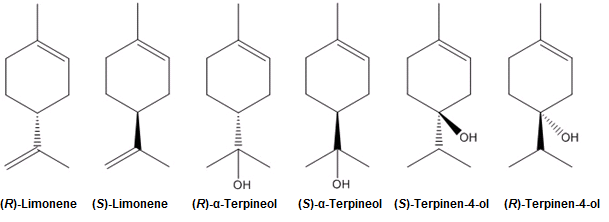
Figure 1: Chemical structures of the monoterpenes studied.
Experiment
Samples and sample preparation
A selection of M. alternifolia tea tree essential oil samples were collected from known Australian plantation sources (authentic; labelled 1–4 here) and commercial retailers (authenticity unknown; labelled 7–15 here; 5 and 6 are commercial Australian samples; the others are from sources around the world), provided by Mr Tony Larkman, Australian Tea Tree Industry Association. Prior to analysis, the oil was diluted to 0.25% (v/v) in acetone.
Instrumentation
eGC-FID
A Network GC System model 6850 (Agilent Technologies, Mulgrave, Australia), with a Supelco Astec CHIRALDEX β-PM (2,3,6-tri-O-methyl derivatised β-cyclodextrin phase; Sigma-Aldrich, Bellefonte) column of 30 m × 0.25 mm I.D., film thickness (df) of 0.12 µm was used for eGC-FID analysis. The chromatographic conditions were as follows: temperature program, 50 °C to 80 °C at 3 °C/min, then to 105 °C at 10 °C/min, followed by 3 °C/min to 120 °C then 10 °C/min to 180 °C. The carrier gas was hydrogen at flow rate of 1.5 mL min-1; FID temperature, 230 °C; injector temperature, 230 °C; injection volume, 0.2 µL and using a split ratio of 100. Data was processed using ChemStation software.
GC–eGC-QMS
The eMDGC-QMS system consisted of an Agilent 7890A GC system, equipped with a 5975c quadrupole MS (QMS; Agilent Technologies), a flame ionisation detector (FID), a Deans switch transfer device, and an autosampler. The 1D column was a Rxi-17Sil MS column (30 m × 0.25 mm I.D., df 0.25 µm) while the 2D column was the same as used in eGC-FID experiments above. The operational chromatographic conditions were as follows: temperature programme: 110 °C to 150 °C at 13 °C/min, then to 160 °C at 10 °C/min (hold 1 min), followed by 13 °C/min to 180 °C. Cool to 50 °C at 60 °C/min (hold 30 s), then heat to 80 °C at 10 °C/min followed by 3 °C/min to 120 °C. Split/splitless injection (230 °C); injection volume: 0.2 µL at a split ratio of 100. Carrier gas: He at constant gas linear velocity 1D: 1.0 mL/min; 2D: 2.0 mL/min. The MS transfer line temperature was 260 ˚C, EI mode at 70 eV, and mass scan range of m/z 40 ─ 200. Selected-ion monitoring (SIM) mode was used at m/z 68. The instrumental set-up for the GC–eGC-QMS system is shown in Figure 2.
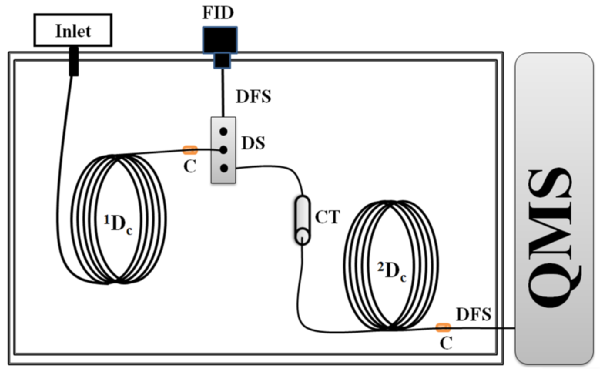
Figure 2: Instrument schematic for GC–eGC-QMS arrangement. DS, Deans switch; DFS, deactivated fused-silica transfer line; 1Dc, first dimension column (Rxi-17Sil MS); 2Dc, second dimension column (Supelco Astec CHIRALDEX β-PM); CT, cryotrap; C, capillary union; FID, flame ionisation detector; QMS, quadrupole mass spectrometry.
Results and discussion
eGC-FID
In enantioselective analysis, separation is highly dependent on the selectivity of the chiral stationary phase (CSP) where the degree of interaction (both inclusion and surface interaction) differs according to the chemistry of the compound. Therefore, a number of chiral columns with different CSPs (di-O-pentyl-3-trifluroacetyl γ-CD, permethylated β-CD, di-O-methyl-6-t-butyl silyl derivative of β-CD, and tri-O-methyl derivative of β-CD) were tested. Separation of the standard racemic target analytes was satisfactory for the Supelco Astec CHIRALDEX β-PM column, so this was used for all subsequent work. Both oven temperature programme and injection volumes were studied to determine optimum parameters for analyte separation. This method was then applied to determine (R,S)-limonene, (R,S)-terpinen-4-ol and (R,S)–α-terpineol in TTO samples. Results (Figure 3) indicated that both enantiomers of limonene were overlapped with an interfering peak, while enantiomers of terpinen-4-ol and α-terpineol were suitably resolved. Co-elution of peaks in single dimensional GC analysis is not unexpected, where the peak capacity of the mono-dimensional system tends to be readily exceeded, so even apparent single peaks must be carefully checked. In Figure 3, it can be clearly observed that both limonene enantiomers overlap with an interfering peak (the composition of limonene in TTO normally ranges around 0.5 to 4%), with interference more severe for (S)-limonene. The interfering peak was found to be p-cymene, a monoterpenic component common in TTO (composition ranging from 0.5 to 12%) (Carson and Riley, 1995: 264–69){Carson, 1995 #3}. Co-elution was confirmed by separately injecting a racemic limonene standard and also a p-cymene standard into the system. In order to resolve (R,S)-limonene from the interfering peak, the more selective GC technique of GC–eGC, which offers higher separation power, was investigated.
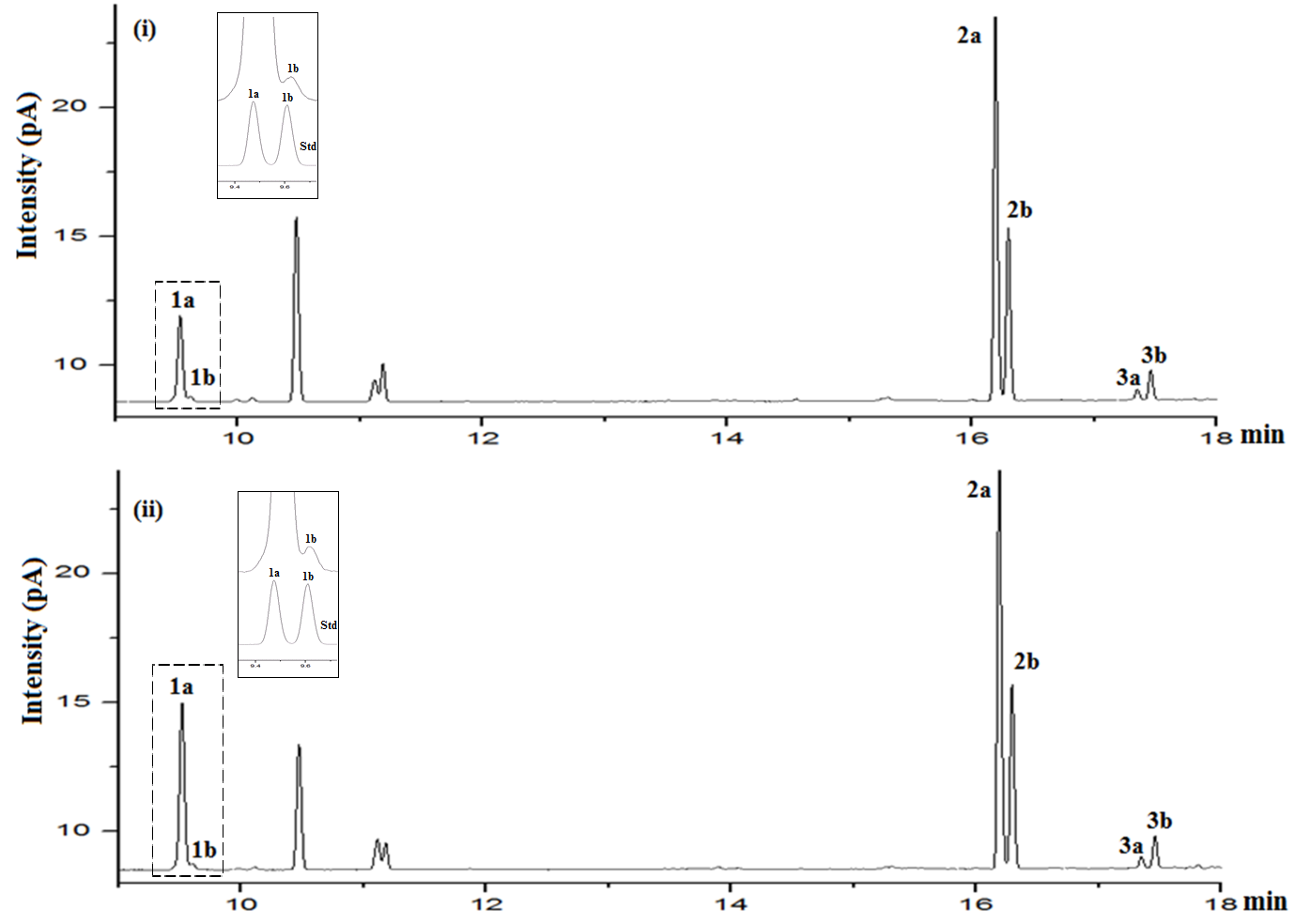
Figure 3: Chromatograms of TTO (i) sample 1 and (ii) sample 2 analysed using eGC-FID. Peaks: 1a, (S)-limonene; 1b, (R)-limonene; 2a, (S)-terpinen-4-ol; 2b, (R)-terpinen-4-ol; 3a, (S)-α-terpineol; and 3b, (R)-α-terpineol. Note that (S)-limonene co-eluted with p-cymene in both samples. The inset shows a racemic limonene standard (Std).
MDGC-QMS
In order to resolve limonene co-elution of the interfering peak, a number of 1D columns with different stationary phases were tested. The aim here is to separate the interference from unresolved (R,S)-limonene using an achiral 1D phase, then to use the enantioselective 2D column for enantiomer resolution. Only the mid-polarity column provided adequate separation of limonene from the interfering peak; the non-polar (NP), polar (P), and ionic liquid (IL) columns were unsatisfactory. Thus, the Rxi-17Sil MS – CHIRALDEX β-PM arrangement was employed for GC-eGC throughout the remainder of this work.
The elution temperatures of terpinen-4-ol and α-terpineol gradually increase from a non-polar column to a polar wax column (Figure 4), due to hydrogen bonding interactions between hydroxyl groups on the polar compounds and the column stationary phase. CSPs tend to be sensitive to temperature changes (chiral recognition differences and resolution of chiral analytes decrease at higher T) so different temperature ramp rates were tested. After careful tuning, the optimum temperature program for suitable separation in acceptable elution time was: 110 °C to 150 °C at 13 °C/min, then to 160 °C at 10 °C/min (hold 1 min), followed by 13 °C/min to 180 °C, then cool to 50 °C at 60 °C/min (hold 30 s), finally heat to 80 °C at 10 °C/min followed by 3 °C/min to 120 °C. Further improved resolution results at lower ramp rates, but this increases analysis time considerably.
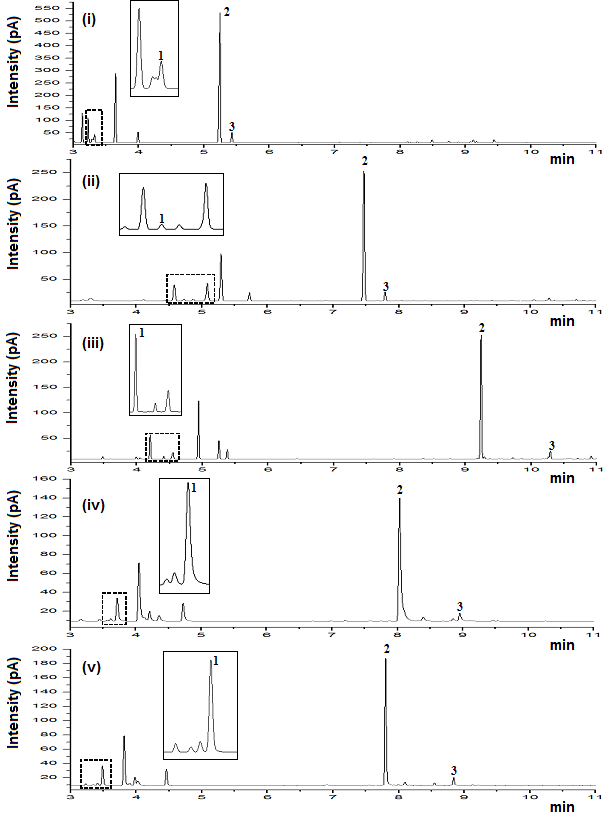
Figure 4: Chromatograms of a TTO sample obtained on different 1D columns, analysed using GC-FID. (i) SLB-5ms; (ii) Rxi-17Sil MS; (iii) SUPELCOWAX 10; (iv) SLB-IL59; and (v) SLB-IL61 columns. Peaks: 1: limonene; 2: terpinen-4-ol; and 3: α-terpineol.
Three randomly selected samples (3, 4 and 10) were each injected four times (n = 4) into the GC–eGC-QMS system. The enantiomeric ratios for each injection were evaluated and the relative standard deviation, RSD (%), was calculated (Table 1). The RSD is below 1% in all cases and hence the intra-day precision for the method satisfactory.
| Relative standard deviations, RSD (%) | ||||||
|---|---|---|---|---|---|---|
| Sample | Enantiomer fractions - Intra-day precision (n = 4) | |||||
| (S)-L | (R)-L | (S)-T1 | (R)-T1 | (S)-T2 | (R)-T2 | |
| Sample 3 | 0.20 | 0.13 | 0.37 | 0.57 | 0.41 | 0.11 |
| Sample 4 | 0.25 | 0.16 | 0.08 | 0.13 | 0.23 | 0.06 |
| Sample 10 | 0.62 | 0.44 | 0.53 | 0.39 | 0.34 | 0.05 |
Table 1: Relative standard deviations RSD (%), of enantiomeric fractions in TTO samples 3, 4 and 10. L: limonene; T1: terpinen-4-ol; T2: α-terpineol.
Figure 5 illustrates the heart-cutting process of the GC–eGC system where the targeted peaks were efficiently heart-cut to the 2D column for enantioselective separation. No interference was observed in the second dimension separation, indicating excellent selectivity of the developed method. Conventionally, enantioselective separation of TTO is normally focused on terpinen-4-ol, the major component in TTO. However, it is inappropriate to monitor only a single peak to detect adulteration; a more stringent method with multiple points of comparison is required since adding other oils to TTO would have to ensure each target compound had the same reference range of acceptable enantiomeric fractions as in authentic TTO. Thus three chiral compounds were chosen for chiral quantification to give a better indication of possible adulteration.
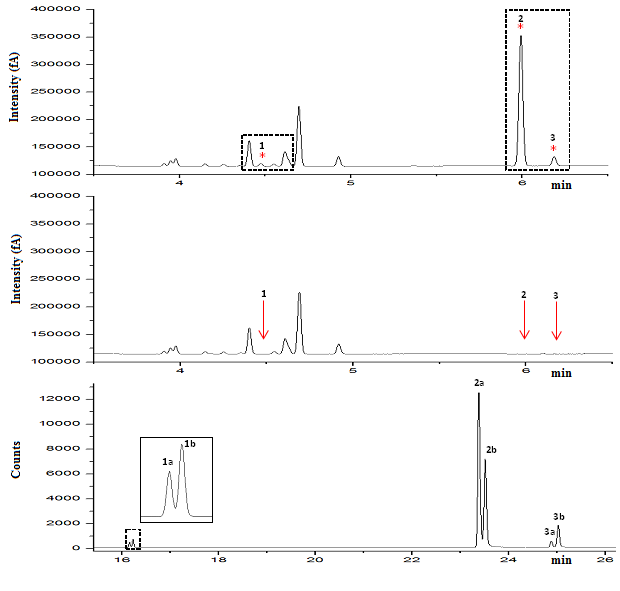
Figure 5: Chromatograms of TTO sample 3, illustrating the heart-cut operation with GC–eGC-QMS. (i) 1D-FID response of whole TTO; (ii) 1D-FID response of TTO sample with limonene, terpinen-4-ol and α-terpineol heart-cut to 2D thus their peaks are missing from the monitor detector response as shown; (iii) MS response (SIM mode) for elution of the heart-cut compounds on 2D. Peaks: 1a: (S)-limonene; 1b: (R)-limonene; 2a: (S)-terpinen-4-ol; 2b: (R)-terpinen-4-ol; 3a: (S)-α-terpineol; and 3b: (R)-α-terpineol.
| Enantiomeric fractions (%) | ||||||
|---|---|---|---|---|---|---|
| Sample | (S)-L | (R)-L | (S)-T1 | (R)-T1 | (S)-T2 | (R)-T2 |
| 1 | 37.04 | 62.96 | 64.55 | 35.45 | 17.64 | 82.36 |
| 2 | 39.26 | 60.74 | 60.63 | 39.37 | 21.76 | 78.24 |
| 3 | 39.39 | 60.61 | 60.28 | 39.72 | 21.31 | 78.69 |
| 4 | 38.71 | 61.29 | 60.97 | 39.03 | 20.01 | 79.99 |
| 5 | 38.84 | 61.16 | 60.47 | 39.53 | 21.52 | 78.48 |
| 6 | 37.23 | 62.77 | 60.88 | 39.12 | 20.73 | 79.27 |
| 7 | 7.31 | 92.69 | 43.46 | 56.54 | 40.06 | 59.94 |
| 8 | 40.87 | 59.13 | 49.71 | 50.29 | 20.23 | 79.77 |
| 9 | 36.72 | 63.28 | 31.31 | 68.69 | 20.10 | 79.90 |
| 10 | 41.44 | 58.56 | 42.62 | 57.38 | 12.85 | 87.15 |
| 11 | 38.51 | 61.49 | 59.11 | 40.89 | 19.59 | 80.41 |
| 12 | 39.73 | 60.27 | 58.93 | 41.07 | 22.28 | 77.72 |
| 13 | 37.29 | 62.71 | 26.46 | 73.54 | 14.11 | 85.89 |
| 14 | 14.74 | 85.26 | 48.56 | 51.44 | 18.19 | 81.81 |
| 15 | 23.63 | 76.37 | 56.07 | 43.93 | 25.29 | 74.71 |
Table 2: Enantiomeric fractions in TTO sample 1 to sample 15 analysed using GC–eGC-QMS. Data corresponds to Figure 6. L: limonene; T1: terpinen-4-ol; T2: α-terpineol.
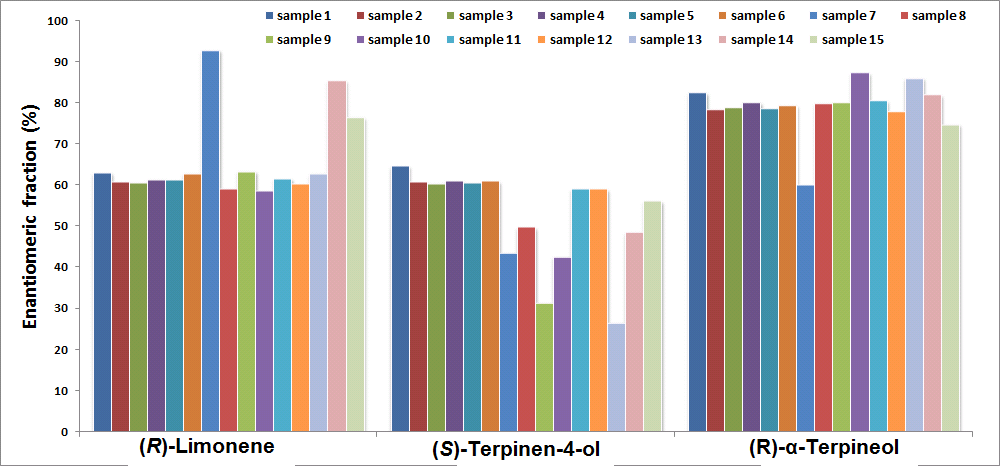
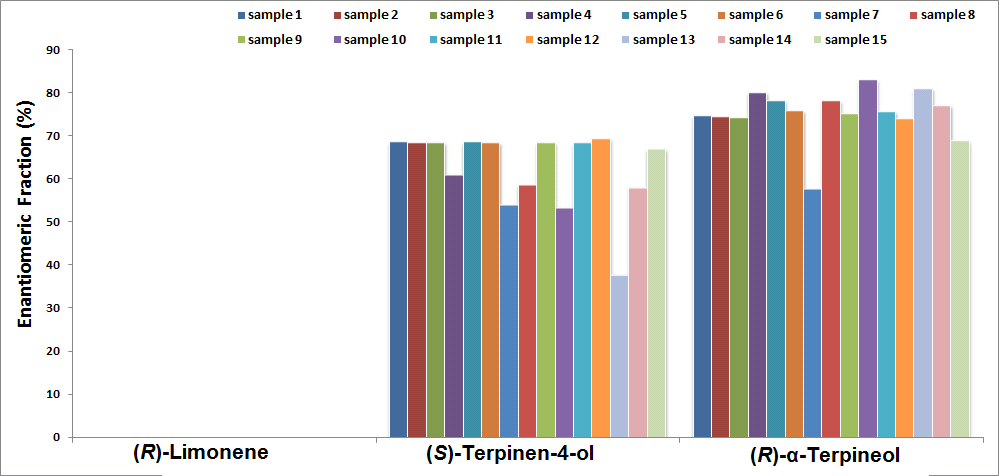
Figure 6: Enantiomeric fractions in TTO sample 1 to sample 15 analysed using (i) eGC-FID (limonene data not available in single eGC analysis due to p-cymene interference) and (ii) GC–eGC-QMS. Note that only one enantiomer is indicated here, since the other enantiomer simply makes up the balance to 100%. Samples 1–4 are the Australian sourced plantation reference data.
From data presented in Figure 6, it is suggested that terpinen-4-ol and α-terpineol may also co-elute with interfering peaks when using eGC-FID. This is due to the differences in enantiomeric fractions for the identical compounds between eGC-FID and GC-eGC-QMS. Terpinen-4-ol analysis using eGC-FID gives a ratio of approximately 68.5% (S)-terpinen-4-ol to 31.5% (R)-terpinen-4-ol, but for GC–eGC the ratio is approximately 61.7% (S)-terpinen-4-ol to 38.3% (R)-terpinen-4-ol. This suggests that in eGC-FID the (S)-terpinen-4-ol peak might co-elute with an unwanted compound giving a higher enantiomeric fraction than in GC–eGC. This also applies to α-terpineol as the ratio comparison for each method is also not consistent. Since MS data for terpenes are often similar, choosing the m/z 68 ion is not a guarantee of having zero interference. Therefore the need for GC–eGC is concluded, not only for limonene but all targeted compounds in this study. The reference plantation TTO all have consistent enantiomeric fractions (Figure 6, data 1–4)
If each commercial sample tested was 100% pure (no interference; each authentic), the enantiomeric fraction of each enantiomer is expected to be constant. Data shown in Figure 6 (data 7–15) suggests otherwise, as there is little consistency among the values presented. For example, sample 13 consists of 26% (S)-terpinen-4-ol and 74% (R)-terpinen-4-ol, which does not correlate to the general ratio noted for reference TTO. The largest enantiomeric fractions observed for (R)-limonene, (R)-terpinen-4-ol and (R)-α-terpineol were 92.69% (sample 7), 73.54% (sample 13) and 87.15% (sample 13) respectively. This compared to the smallest fraction at 58.56% (sample 10), 35.45% (sample 1) and 59.94% (sample 7) respectively. From this, there is a large variation in the enantiomeric fraction of all the samples analysed. Hence, it is rather difficult to determine the authenticity of the TTO without an appropriate point of reference. Finally, a benchmark for the true enantiomeric fraction of TTO is needed for the classification of adulterated TTO in comparison to the pure oil.
Conclusion
The GC–eGC-QMS system provides a useful alternative for the determination of enantiomeric distributions of limonene, terpinen-4-ol and α-terpineol in TTO, where conventional eGC is insufficient to adequately resolve these components from sample matrix component(s). Further work expected in this field includes: (i) a more thorough validation of the GC–eGC approach (e.g. linearity, limits of detection, inter-day precision and recovery); (ii) investigation of the inter-relationship of enantiomeric fractions with analyte quantities via the heart-cutting process, with quantification vs internal standards; and (iii) generating more comprehensive and representative data of pure Australian TTO to serve as a point of reference for differentiating adulterated oils. This work has demonstrated that the GC–eGC approach remains the best option in providing a more complete separation of target components here, that cannot be achieved via conventional eGC.
Acknowledgements
The authors thank Dr Sung-Tong Chin for his expert advice and assistance with aspects of instrumental analysis.
List of figures
Figure 1: Chemical structures of the monoterpenes studied.
Figure 2: Instrument schematic for GC–eGC arrangement.
Figure 3: Chromatograms of TTO sample 1 and TTO sample 2 analysed using eGC-FID.
Figure 4: Chromatograms of TTO, obtained on different 1D columns, analysed using GC-FID.
Figure 5: Chromatograms of TTO sample 3, illustrating the heart-cut operation of GC–eGC-QMS.
Figure 6: Charts of enantiomeric fractions in TTO sample 1-15 using eGC-FID and GC–eGC.
List of tables
Table 1: Relative standard deviation (%) of enantiomeric fractions in TTO samples 3, 4 and 10.
Table 2: Data for enantiomeric fractions in TTO sample 1 to 15 using eGC-FID and GC–eGC-QMS.
Notes
[1] Rachel West has recently finished her masters in chemistry at the University of Warwick and is now a Teacher of Science.
[2] Yong Foo Wong is a PhD candidate in the School of Chemistry, Faculty of Science, Monash University. He was awarded a Master of Science degree from the Universiti Sains Malaysia in Oct 2013. His current research interests include development of high-resolution metabolic profiling approaches (MDGC and GC×GC with advanced mass spectrometry) for essential oils and plant extracts, and authenticity assessment of essential oils. He is the author of 8 research articles.
[3] Philip Marriott is a Professor in the School of Chemistry, Monash University, Australia, and Deputy Director of the Australian Centre for Research on Separation Science (ACROSS). Previous appointments were at the University of Bristol, National University of Singapore, and RMIT University. He is active in high resolution separations and mass spectrometry, and leads research programmes in comprehensive two-dimensional gas chromatography (GC×GC) and multidimensional gas chromatography (MDGC). He has published about 340 research papers and book chapters.
References
Brophy, J. J., L. A. Craven and J. C. Doran (2013), Melaleucas: their botany, essential oils and uses, Canberra: Australian Centre for International Agricultural Research, Rural Industries Research and Development Corporation
Carson, C. F. and T. V. Riley (1995), 'Antimicrobial activity of the major components of the essential oil of Melaleuca alternifolia', Journal of Applied Bacteriology, 78 (3), 264–69
Govindasamy, R., S. Arumugam and J. E. Simon (2013), 'An assessment of the essential oil and aromatic plant industry with a focus on Africa', in Juliani, H. R., J. E. Simon and C.-T. Ho (eds), African Natural Plant Products: Vol II Discoveries and Challenges in Chemistry, Health, and Nutrition, Washington, DC: American Chemical Society, pp. 289–321
Sciarrone, D., C. Ragonese, C. Carnovale, A. Piperno, P. Dugo, G. Dugo and L. Mondello (2010), 'Evaluation of tea tree oil quality and ascaridole: A deep study by means of chiral and multi heart-cuts multidimensional gas chromatography system coupled to mass spectrometry detection', Journal of Chromatography A, 1217 (41), 6422–27
Shellie, R., P. Marriott and C. Cornwell (2001), 'Application of comprehensive two-dimensional gas chromatography (GC×GC) to the enantioselective analysis of essential oils', Journal of Separation Science, 24 (10–11), 823–30
Simmons, M. C. and L. R. Snyder (1958), 'Two-stage gas-liquid chromatography', Analytical Chemistry, 30 (1), 32–35
Tisserand, R. and R. Young (2014), Essential oil safety: A guide for health care professionals, 2nd ed., London: Churchill Livingstone Elsevier Health Sciences.
Wong, Y. F., N. W. Davies, S.-T. Chin, T. Larkman and P. J. Marriott (2015), 'Enantiomeric distribution of selected terpenes for authenticity assessment of Australian Melaleuca alternifolia oil', Industrial Crops and Products, 67, 475–83
Wang, M., J. Zhao, B. Avula, Y.-H. Wang, A. G. Chittiboyina, J. F. Parcher and I. A. Khan (2015), 'Quality evaluation of terpinen-4-ol-type Australian tea tree oils and commercial products: An integrated approach using conventional and chiral GC/MS combined with chemometrics', Journal of Agricultural and Food Chemistry, 63 (10), 2674–82
To cite this paper please use the following details: West, R. Wong, Y.F. and Marriott, P.J (2015), 'Enantioselective Multidimensional Gas Chromatography for the Analysis of Selected Monoterpenic Compounds in Melaleuca alternifolia (Tea Tree) oil', Reinvention: an International Journal of Undergraduate Research, Volume 8, Issue 2, http://www.warwick.ac.uk/reinventionjournal/issues/volume8issue2/west Date accessed [insert date]. If you cite this article or use it in any teaching or other related activities please let us know by e-mailing us at Reinventionjournal at warwick dot ac dot uk.